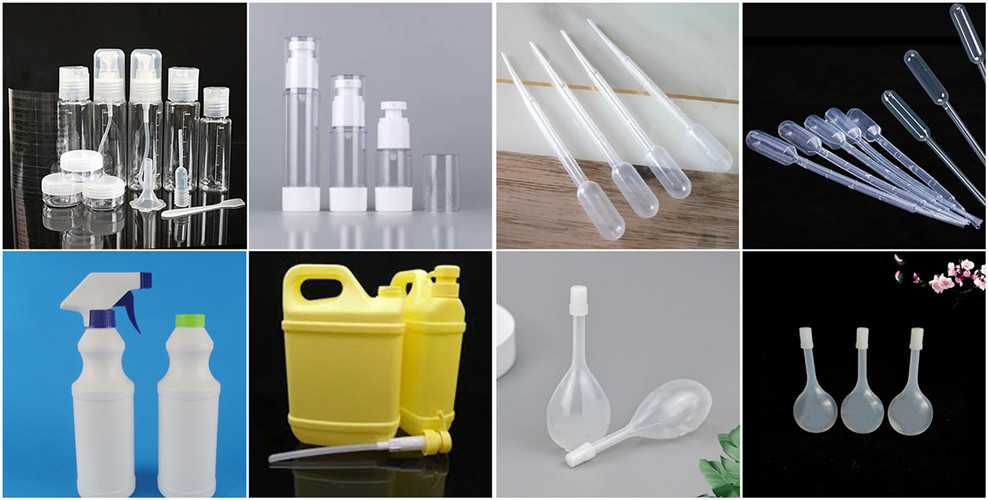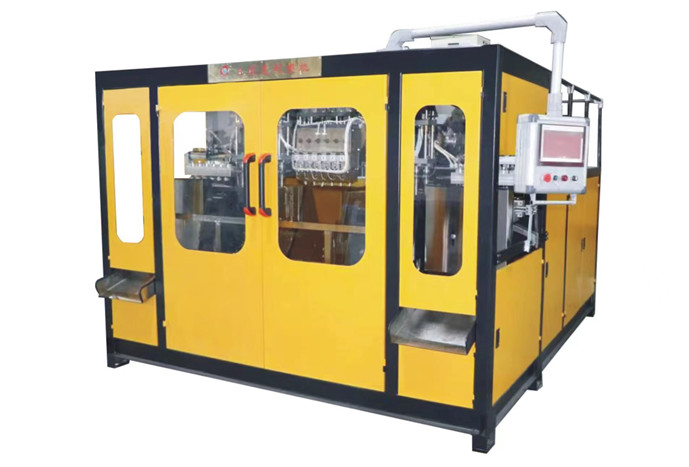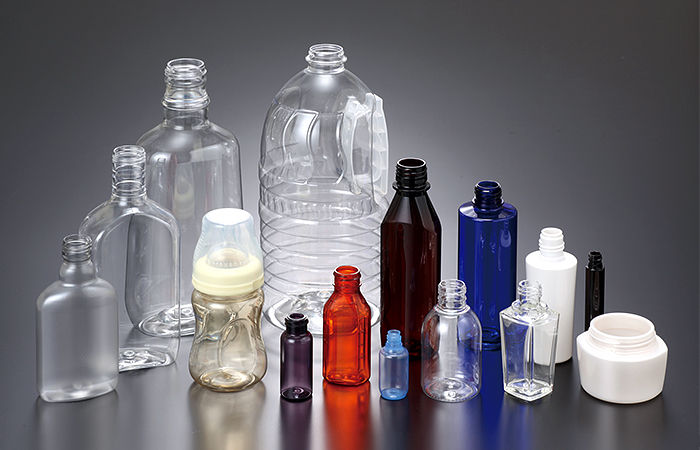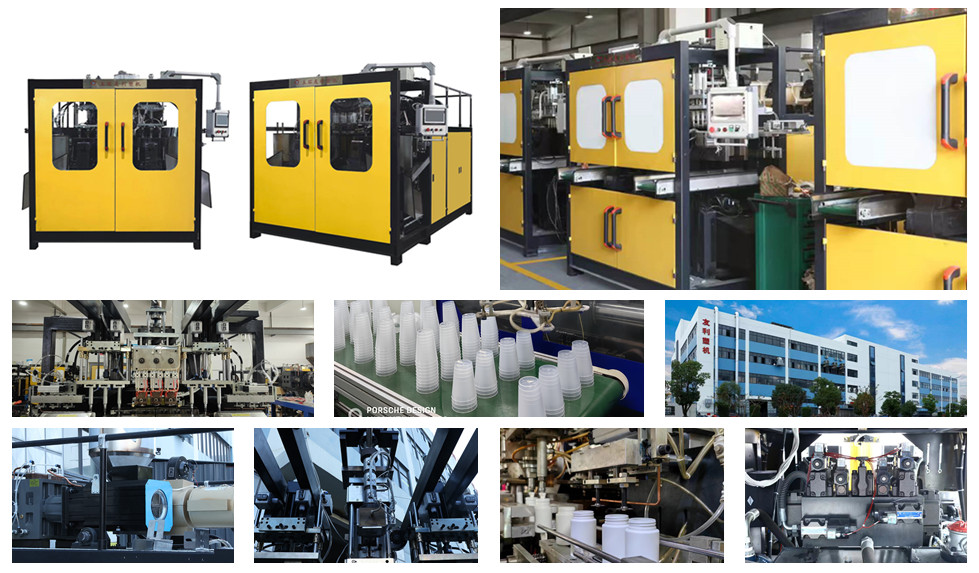How Does a Blow Molding Machine Work ?
How Does a Blow Molding Machine Work ?
Blow molding can be found around you and you don’t even know it. That soda that you drinking has a plastic bottle, which is blow-molded.Every day hollow plastic items such as milk cartons, shampoo tubes, storage drums, and watering cans are all made using a specific manufacturing process: blow molding. The adaptable method allows for the formation of thin-walled, hollow plastic containers by applying molten thermoplastic to a mold and shaping it as required by blowing compressed air inside. Polyethylene, polypropylene, polyethylene terephthalate (PET), and polyvinyl chloride (PVC) are popular plastics used in this method.
Overview of Blow Molding
Blow molding, also known as blow moulding in the United Kingdom, is a molding process in which heated plastic is blown into a mold cavity to create a hollow object. The defining characteristic of blow molding is that it’s used to create hollow objects. Raw plastic is first heated, after which it’s formed into a parison. Next, the plastic parison is secured to the top of the mold. Finally, the air is blown down onto the plastic parison, thereby stretching it across the interior walls of the mold cavity.
Types of Blow Molding
1. Extrusion Blow Molding
Extrusion blow molding is the most common form of blow molding. It begins with melting plastic resin and extruding it into a parison (a hollow tube). The parison is then placed in a mold, and compressed air is used to blow it into the desired shape.
2. Injection Blow Molding
Injection blow molding is suitable for smaller, more intricate parts. It starts with injecting melted plastic into a mold cavity, which is then rotated and blown into shape.
3. Stretch Blow Molding
Stretch blow molding is used primarily for PET (Polyethylene terephthalate) bottles. It involves stretching the parison before blowing it into the mold, resulting in a stronger and more transparent container.
History of Blow Molding
Blow molding is a manufacturing process used to create hollow plastic parts. The process involves heating or melting plastic resin and shaping it into a hollow form using air pressure. The history of blow molding dates back to the 19th century, with the first recorded use of blow molding in the glass industry. However, it wasn’t until the mid-20th century that the process was applied to plastics.
In 1938, the first patent for a blow molding process was filed by an American inventor, James Hendry. The process involved extruding a parison (a tube of plastic) and inflating it into a blow molding machine to create a hollow object. This process was known as extrusion blow molding and is still widely used today.
In the 1950s, the development of injection molding allowed for the mass production of more complex shapes. This process involves injecting plastic into a core pin, which is then transferred to a blow mold to create the final shape.
Stretch blow molding was developed in the 1970s, allowing for the creation of PET bottles with high clarity and strength. This process involves stretching the plastic preform before inflating it into a mold, creating a strong and lightweight plastic bottle part.
Over the years, blow molding technology has continued to improve, with advancements in materials, machinery, and automation. Today, molding is used to produce a wide range of products, from packaging and automotive parts to toys and medical equipment.
The Blow Molding Process
Blow molding is a fairly straightforward process that includes melting, homogenizing, extruding, molding (blowing), cooling, and ejection.
◆ Plastic Resin Feeding or Charging: The first step in the blow molding process is plastic feeding. This is done by conveying the plastic pellets into the extruder hopper. Vacuum pumps draw pellets from big bags or bulk containers and transfer them into the raw material silos or hoppers. A rotary feeder at the bottom of the silo controls the rate of feeding into the plastifier or extruder. Compressed air is then used to convey the stored pellets to the extruder hopper. In other systems, plastic pellets from big bags or bins can be vacuum conveyed directly to the extruder hopper without the need for a separate conveying air system.
◆ Plasticizing or Melting: As the plastic resin enters and goes through the extrusion machine, it is melted by continuous kneading and heating. Electric heating elements or heating bands are wrapped around the extruder barrel to provide heat for melting the polymer. The extruder screw has different sections that serve a specific purpose. These are feeding, compressing, and metering. The extruder screw is designed to provide sufficient shearing and compression to homogenize and extrude the plastic.
◆ Parison Extrusion or Preform Injection: This process is the preparation of the parison or preform to be inflated. This is done by extruding the plastic through free extrusion or injection into a preform mold. The different processes in producing the preform are discussed in detail in Chapter 3.
◆ Sealing or Clamping: Sealing or clamping involves a split die that captures the preform. The ends of the parison (extrusion blow molding) are sealed except for one hole, typically the container opening, where the compressed air will be injected.
◆ Inflation or Blow Molding: This step is where the plastic takes its form. Compressed air is introduced inside the preform. This inflates the preform until it is molded according to the profile of the die.
◆ Cooling and Ejecting: The next step is the cooling process. Typically, as the plastic touches the die, it cools at a predefined rate which stabilizes the dimensions of the product. After cooling, the mold opens and ejects the product.
◆ Trimming: Flashing is generally evident in extrusion blow molding. Most blow molding machines have auto deflashing features as the dies clamp the preform. But in some instances, flash is present at the top and bottom parts of the product, especially at the opening where compressed air is injected. This excess material is trimmed by a rotating knife. To minimize wastage, some systems collect the excess materials, grind them, and feed them back to the extrusion machine.
◆ Leak Test: This is the typical quality control method used in manufacturing bottles or packaging materials. In this step, either vacuum or compression is generated inside the container. The machine will then check if air enters or escapes the container by monitoring the pressure. If a leak is sensed from the container, it is rejected and fed back into the system.
◆ Other Secondary Processes and Packaging: Secondary processes include labeling, marking, and printing. After completing the secondary processes, the products are packed and distributed to manufacturers or end consumers.
What is a Blow Moulding Machine?
Blow moulding machines are used to manufacture a wide range of plastic products, including bottles, containers, and other hollow shapes. There are several different types of blow molding machines, including extrusion blow molding, injection blow molding, and stretch blow molding.
Blow molding, also known as hollow blow molding, is a rapidly developing plastic processing method. A tubular plastic parison made of thermoplastic resin is molded by extrusion or injection. While still hot or softened by heat, it is placed in an open mold and immediately inflated with compressed air inside the parison, causing the plastic to expand and tightly adhere to the inner walls of the mold. After cooling and demolding, various hollow products are obtained. The manufacturing process of blow-molded films is similar in principle to that of hollow products, but molds are not used. Here, we recommend our Hollow Blow Molding Machine.
The Blow Molding Machine Components
1. Extruder
The process begins with an extruder, which melts and forms the plastic into a parison. This parison is crucial, as it will become the basis for the final product's shape.
2. Mold
The mold is where the magic happens. It's designed to give the plastic its intended shape. Molds can be complex and are highly customizable depending on the product requirements.
3. Blow Pin and Mandrel
These components are responsible for inflating the parison like a balloon to match the mold's shape. The blow pin and mandrel are carefully controlled to ensure precision.
4. Cooling System
After the plastic has taken the shape of the mold, it needs to cool rapidly to maintain its form. Cooling systems, such as air or water, are used to expedite this process.
Working principle of blow molding machine
Simply put, the working principle of a blow molding machine produced by the blow molding machine factory is similar to blowing bubbles. After the plastic and the hopper enter the screw barrel of the extruder, they are pushed toward the head by the rotation of the screw thread. Due to the resistance of the filter, splitter plate, and head die at the head of the machine, as well as the gradually decreasing capacity of the screw thread, the advancing material encounters great resistance, while also being heated by the heat transmitted from the barrel. On the other hand, when the plastic is subjected to forces such as compression, shear, stirring, etc. during movement, friction between the plastic and the barrel, between the screw threads, and between plastic molecules will produce a large amount of heat. Since the temperature of the plastic inside the barrel keeps rising, its physical state gradually changes from the glassy state to the high elastic state, and finally becomes the molten state, further completing plasticization. As the screw continues to rotate, the molten plastic is extruded from the head die in a pressure-balanced and constant amount, forming a plastic product with a certain shape. After cooling and shaping, the extrusion molding work is completed.
Blow Molding Materials
Plastics that are suited for this process include:
◆ PVC
◆ PET
◆ Nylon
◆ ABS
◆ EVA
◆ TPE
◆ Low and High-Density Polyethylene
◆ Polypropylene
◆ Co-polyester
◆ COP and COC
◆ Polystyrene
The wide variety of materials available for use in blow molding means that you can use the process to develop parts to fit your exact needs.
What Is Blow Moulding Used For
Blow molding machines are used to produce a wide range of products, including bottles, containers, and other hollow products. Some common examples of products produced using blow molding include:
◆ Plastic bottles for beverages, such as water, soda, and juice
◆ Plastic containers for food and household products, such as peanut butter jars and laundry detergent bottles
◆ Industrial containers, such as drums and barrels
◆ Automotive parts, such as fuel tanks and bumpers
◆ Toys and recreational products, such as water guns and inflatable pools
In addition to these products, blow molding machines can be used to produce a wide range of other products, including medical devices, toys, and consumer goods. The versatility of blow molding makes it an ideal choice for producing a wide range of products with a uniform wall thickness and a smooth surface finish. Click to see more app options.
Choosing blow molding to bring your product to life is a great solution for mass-producing simple, effective designs without spending too much money. We have a talented team of trained professionals who can take your product from idea to reality. In short, we’ll work with you throughout the design and production processes to ensure that the end result is a product you can be proud of.
So, contact us today so we can assist you in getting your product out of your head and out into the world!
How to use blow molding in different industries?
Blow molding is a manufacturing process used to produce hollow plastic parts by inflating a molten plastic tube or parison within a mold cavity to create a desired shape. Blow molding can be used in various industries, including food and beverage, cosmetics, detergents, industrial, pharmaceuticals, and toys. Here are some general steps for using blow molding in different industries:
① Determine the specific needs and requirements of the industry, such as the type of plastic resin used, the size and shape of the products produced, and the production speed and efficiency of the machine.
② Choose a suitable blow molding machine that meets the industry’s specific needs and requirements.
③ Create a mold design or obtain a pre-existing mold that matches the desired product shape and size.
④ Feed plastic resin into the blow molding machine’s extruder, which heats and melts the resin into a molten state.
⑤ Extrude the molten resin through a die to form a hollow tube or parison.
⑥ Clamp the mold around the parison and inflate it with air or nitrogen to force the plastic against the mold walls and form the desired shape.
⑦ Cool the mold and the plastic part within it, and then release the mold to remove the finished part.
⑧ Trim and finish the plastic part as needed, such as by removing excess material or adding finishing touches.
⑨ Inspect the finished product for quality and compliance with industry standards and regulations.
By following these steps, different industries can use blow molding to produce a variety of plastic products that meet their specific needs and requirements.
YOULI is a leading blow molding machine manufacturer in China, we focus on R&D, manufacturing and sales of 0.5ml-50l blow molding machines. The company has a group of technical backbones and excellent service teams with more than 20 years of experience in the industry and boasts a robust quality management system and an innovative research and development framework. With a strong focus on intellectual property, we hold multiple independent patents, ensuring cutting-edge technologies and exceptional product offerings. Based on its good reputation and excellent service, has been highly praised and trusted by overseas customers.
We have a good understanding of customer needs and provide professional blow molding machine solutions. We would like to be your reliable support partner. If you need to buy a blow molding machine, welcome to contact us!
Can blow molded plastic be recycled?
Yes, blow molded plastic can be recycled. Blow molding is a common manufacturing process used to create plastic products such as bottles, containers, and automotive parts. These products are typically made from polyethylene (PE), polypropylene (PP), or polyethylene terephthalate (PET) plastics, which are all recyclable materials.
The recycling process for blow molded plastic involves shredding the plastic into small pieces, melting it down, and reforming it into new products. However, it’s worth noting that not all recycling programs accept all types of plastic, so it’s important to check with your local recycling program to see if they accept blow molded plastic and if there are any special instructions for preparing it for recycling.
Additionally, it's important to ensure that the plastic is properly cleaned and free from any contaminants before recycling. This helps to ensure that the recycled plastic is of good quality and can be used to create new products.
Blow Molding vs Injection Molding: What's the Difference?
The terms “blow molding” and “injection molding” are often interchangeable when referring to molding processes. While similar, though, they aren’t necessarily the same. Both blow molding and injection molding involve the use of liquid material — typically plastic — that’s forced into a mold cavity. The difference is that blow molding is used to create hollow objects, whereas injection molding is used to create solid objects. For hollow objects, only blow molding offers a fast and effective solution for manufacturing companies.
Why Opt for the Blow Moulding Process?
The main benefit of using the blow moulding plastics process in manufacturing projects is the sheer number of products that can be made using any of the three flexible, efficient methods. Plastic food containers can remain hygienic and attractively branded, while shampoo bottles and soap dispensers offer excellent chemical resistance and the ability to form complex shapes. Automotive ducting and industrial tubs and drums provide robust, durable strength for use in heavy industry, construction and other demanding environments. The medical sector prizes the manufacturing method for its easy sanitization properties and lightweight. Put simply, plastic blow molded products are commonly found in multiple areas of domestic and commercial life.
Other advantages include the fact that extrusion blow moulding, in particular, can produce complex and highly bespoke shapes that can be accurately designed for precise sizes, finishes and wall thicknesses. For example, bottlenecks must match the grooves of the bottle top exactly to ensure a watertight seal once the cap is screwed on. Finished products tend to be of very high quality, yet tooling and manufacturing costs usually remain lower than other types of plastic manufacturing processes, which certainly helps the bottom line.
Disadvantages include the fact that there are limits to how much difference can be made in wall thicknesses due to the fact that the products must be hollowed out yet retain sufficient strength and integrity. Products can also be harder to recycle if thermosetting polymers are used. This is because such materials can only be reshaped once and will no longer be able to be softened or melted for reforming or recycling after that.
◎ The Benefits of Using Blow Molding Machines
Challenges of Blow Molding
Despite the numerous advantages of the molding, there are also some challenges associated with this manufacturing process, including:
① Environmental concerns
One of the most pressing challenges associated with blow-molded plastics is environmental concerns. The production of plastics generates significant amounts of waste and pollution, and improper disposal of these materials can have serious consequences for the environment. Recycling is one solution to this problem, but not all types of plastics can be easily recycled, and the cost of recycling can be prohibitive for some manufacturers. Improving waste management practices and finding innovative ways to recycle and reuse plastic materials are critical steps in reducing the environmental impact of blow-molded plastics.
② Limited color options
Another challenge associated with blow-molded plastics is the limited color options available for these materials. The manufacturing process can make it difficult to achieve certain colors and shades, which can be a limitation for manufacturers who want to create products with specific aesthetic or branding requirements. Some manufacturers may turn to other materials or processes to achieve their desired color scheme, which can increase costs and complexity.
③ Complex shapes
Complex shapes are also a challenge for blow-molded plastics. While this process is well-suited for producing simple, symmetrical shapes, it can be more difficult to achieve complex, irregular shapes. This is because the process relies on the use of molds, and creating molds for complex shapes can be expensive and time-consuming.
④ High production costs
Finally, high production costs for small quantities can also be a challenge for manufacturers using blow-molded plastics. The specialized equipment and tooling required for this process can make it prohibitively expensive for small-scale production runs. This can limit the ability of small businesses to use blow-molded plastics in their products and can result in higher costs for consumers.
253
0
0






Comments
All Comments (0)